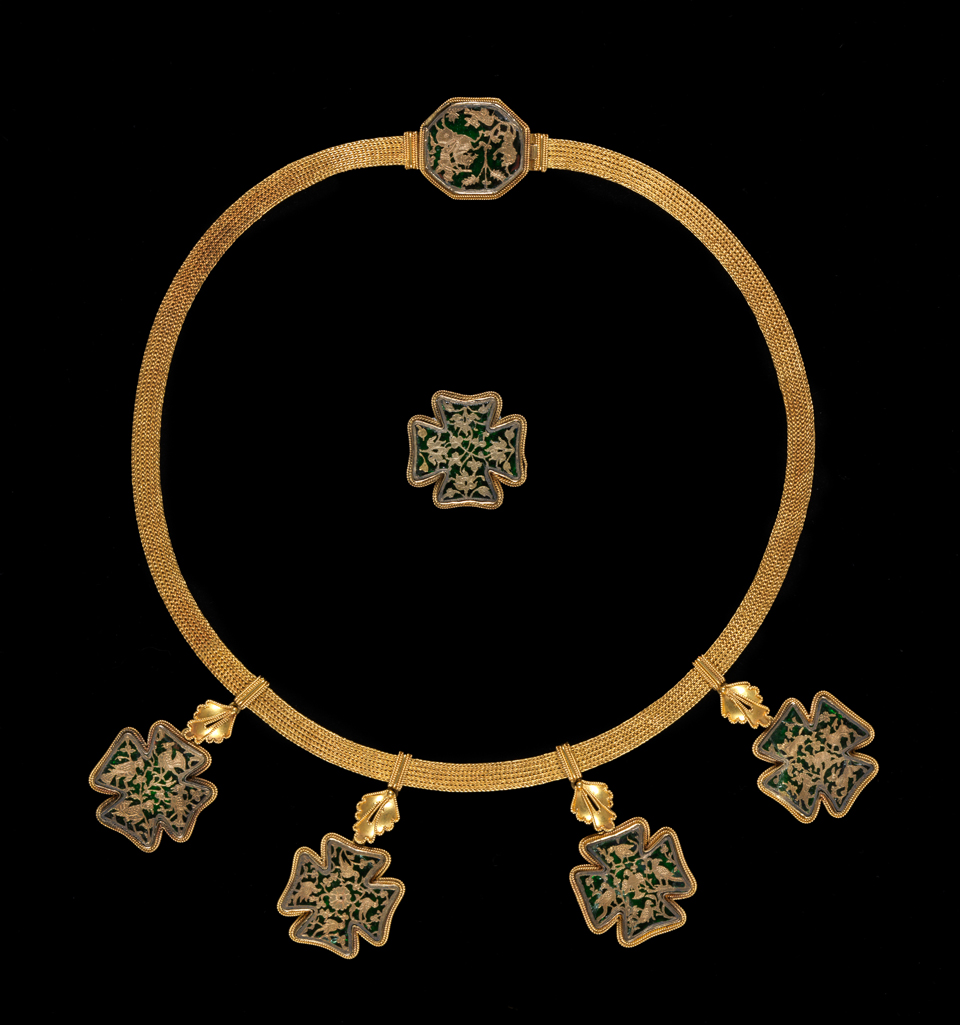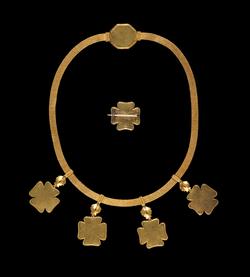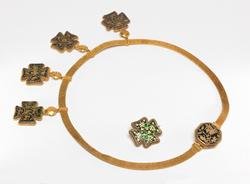Current Location: In storage
Maker(s)
Maker:
Phillips Brothers
Entities
Categories
Description
Gold and Partabgarh green glass. The necklace is composed of a flexible, woven gold strip, from which are suspended four gold leaves, each attached to a shamrock-shaped pendant of Partabgarh green glass, with chased and pierced gold inlay depicting plants and animals, mounted in gold with rope-twist border. At centre back there is an octagonal clasp of the same materials. The brooch, en suite with the pendants, has a pin-fastening across the back. In original red leather case, the silk lining of the lid of which is printed in gold beneath a crown 'PHILLIPS. / 23 COCKSPUR ST / LONDON'
Notes
History note: Wartski, Grafton Street, London, W1
Legal notes
Given by Mrs J. Hull Grundy
Acquisition and important dates
Method of acquisition: Given
(1983)
by
Hull Grundy, J., Mrs
Dating
Victoria I
Circa
1855
CE
-
1869
CE
Note
The glass, Indian; 19th century. The mounts, English, London
The firm of Phillips Brothers was one of the most productive and successful London jewellers of the nineteenth century. Their range and variety was unsurpassed and included jewellery in the Italian archaeological style, the Renaissance Revival style (copying the jewels depicted in drawings by artist Hans Holbein, 1497/8-1543), as well as pieces inspired by the jewellery of India and Scandinavia. Phillips was also influenced by the objects discovered by Sir Henry Layard during his excavations at Nimrud, an ancient Assyrian city of Upper Mesopotamia (near modernday Mosul, Iraq).
Phillips was also one of the first to popularise Indian jewellery, taking advantage of the growing interest in the art of India after the magnificent display of Indian craftsmanship at the Great Exhibition (1851) and the publication of Indian designs in Owen Jones’s 'Grammar of Ornament' (1856). Phillips imported particular elements from India and mounted them into settings made to suit Western styles of dress and fashions. The most commonly imported elements were small plaques of Indian glass and gold work, known as theva work (seen here), first made predominantly in the region of Pratapgarh, Rajasthan.
Components of the work
Part
composed of
glass
( green, Partabgarh, India)
gold
Case
composed of
leather
( red)
Case Lining
composed of
silk
Necklace
Length 39.5 cm
Brooch
Width 2 cm
Inscription or legends present
Inscription present: PHILLIPS./23 COCKSPUR ST/LONDON beneath a crown
- Text: PHILLIPS./23 COCKSPUR ST/LONDON
- Location: Inside case lid
- Type: Print
References and bibliographic entries
Related exhibitions
Identification numbers
Accession number: M.18 & A & B-1983
Primary reference Number: 119116
Stable URI
Audit data
Created: Saturday 6 August 2011
Updated: Tuesday 26 March 2024
Last processed: Thursday 14 August 2025
Associated departments & institutions
Owner or interested party:
The Fitzwilliam Museum
Associated department:
Applied Arts

 IIIF Manifest
IIIF Manifest








